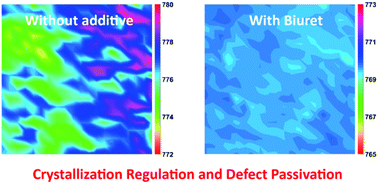Thermally stable perovskite solar cells with efficiency over 21% via a bifunctional additive†
Abstract
The rapid improvements in the performance of organic–inorganic perovskite solar cells have been astonishing but their commercialized production requires further achievements on device stability and efficiency. Herein, we introduce a bifunctional additive, biuret, with multiple Lewis base groups to regulate the crystallization process of perovskite crystals and passivate the defects at grain boundaries. Compared with the control, methylammonium lead iodide (MAPbI3), films processed with biuret exhibit increased grain size, reduced trap state density, and more uniform local photoluminescence. The addition of biuret leads to suppressed trap-assisted nonradiative recombination and an efficiency improvement from 18.26% to 21.16%, which is among the highest efficiency for MAPbI3 solar cells with the mesoscopic structure. Meanwhile, as biuret interacts with uncoordinated Pb2+ and iodide from the iodoplumbate complex on two adjacent perovskite grains, the thermal durability of the MAPbI3 film is enhanced due to the crosslink through chemical bonding. Under 85 °C annealing in nitrogen, the biuret-modified device retains 94% of its initial efficiency after 12 days while the control cells lose more than half the efficiency.



 Please wait while we load your content...
Please wait while we load your content...